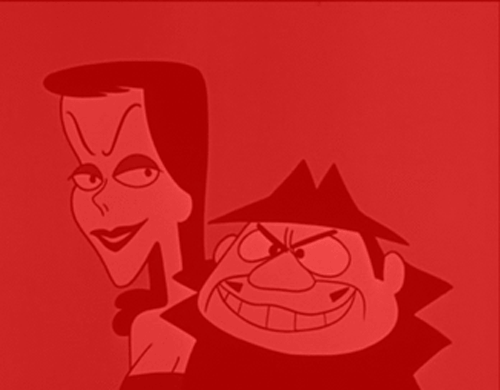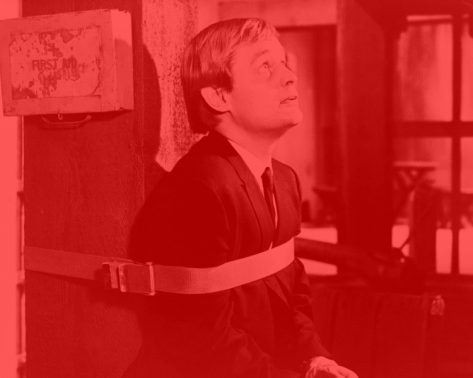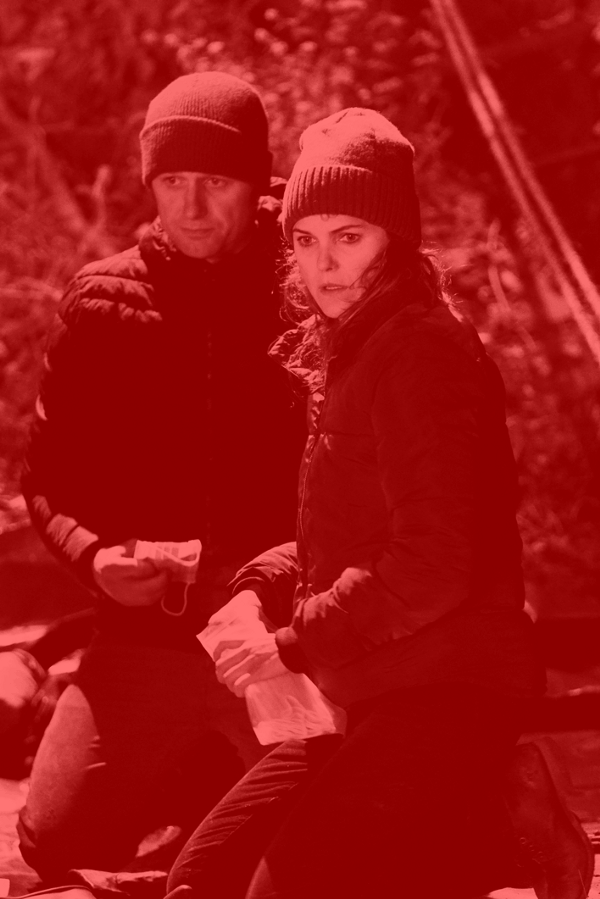We don’t really want to live in a world without Russian villains.
At least, we don’t want to live in a pop culture world without them. From the first frost of the Cold War, our TV and movie screens have been flooded with Soviet baddies: ruthless and cunning, humorless and tough, with thick mustaches and even thicker accents.
Boris and Natasha made their animated debut on Rocky and Bullwinkle in 1959, and they were followed, in near-ceaseless succession, by a parade of Soviet antagonists. The 1960s alone brought The Manchurian Candidate (1962), From Russia with Love (1963), Dr. Strangelove (1964), The Russians Are Coming, the Russians Are Coming (1966), and Ice Station Zebra (1968). The trend waned a bit in the 1970s — though we still saw Nikolai Dalchimsky, a brainwashed Soviet sleeper agent, in 1977’s Telefon — but picked up again by 1985, when Rocky IV’s Ivan Drago and Rambo II’s Sgt. Yushin appeared.
No villain has endured in our cinematic imagination quite like the Russian.
By 1983, the Russian threat was coming into American homes with The Day After, one of the most terrifying TV movies ever made, in which a small town in eastern Kansas is utterly destroyed by a nuclear holocaust. Guess who was responsible for that missile strike? (In a Russian-nesting-dolls feat of storytelling, a fourth season episode of The Americans, the acclaimed FX drama about a husband-and-wife team of Russian spies deep undercover in the United States, is centered around the spies’ teenage daughter watching, and being horrified by, The Day After’s total annihilation.)

The fall of the Soviet Union did little to stem Hollywood’s reliance on the evil Russian trope. It was a Soviet hijacker who attacked Air Force One in 1997, several seasons worth of Russian foils handed ass-kickings on Alias in the early 2000s, a near-unbeatable Russian ice hockey team trumped by team U.S.A. in 2004’s nostalgia-fest, Miracle. And today, of course, we have The Americans, which premiered in 2013 and reimagines our evergreen Russian nemesis in what is perhaps the scariest iteration of all: As an enemy who looks — who maybe is — exactly like us.
Real life has afforded the United States plenty of alternative adversaries: Nazis, terrorists, private email servers. Enemies foreign and domestic abound. But no villain has endured in our cinematic imagination quite like the Russian. Why can’t we let go of the Soviet foes? What is so compelling, versatile, and vital about this remarkably enduring archetype? And what does the rising sense that, in real life, Russia is potentially a threat to American democracy once more mean for the Russians on our screens?
First, let’s define the terms: What makes a classic Russian villain?
“One of the ways you know how prevalent this is is, you don’t even have to close your eyes to think of: What is the stereotype of a Russian villain?” said Robert Thompson, founding director of the Bleier Center for Television & Popular Culture at Syracuse University’s Newhouse School. “We all know what that is. It’s so clear. Humorless, cold. Overly, ruthlessly logical. Robotic. A really thick accent. We know that Russian villain.”
The archetype is at least as old as Rocky and Bullwinkle. Boris Badanov (a riff on Boris Godunov, a Russian Tsar in the late 1500s) and Natasha Fatale take orders from an off-screen, never-seen Fearless Leader. They both have heavy accents, eyebrows drawn with a mischievous arch; she wears a slinky purple dress, he has, of course, a mustache.
Sure, Boris and Natasha were “bumbling, incompetent foils,” Thompson said, and not exactly the nefarious masterminds who terrify American schoolchildren into practicing duck and cover drills. But, he pointed out, what may have “looked like a standard kids show” on the surface in fact provided “this early Cold War representations of Russians [who] had infiltrated” quiet corners of the United States. Rocky and Bullwinkle was set in Frostbite Falls, Minnesota. “Boris and Natasha were, to some extent, the first sleeper cell,” Thompson said.

Since the late 1950s, that outline of a Russian villain has remained so instantly recognizable that even villains who aren’t explicitly Russian — or aren’t Russian at all — can have some of these signifiers, because audiences so readily connect these characteristics with The Bad Guy. Think of Gru in Despicable Me, with his Eastern Bloc accent, or Voldemort from the Harry Potter movies, a Brit whose face is particularly Putinesque.
As for Boris and Natasha, our iconic Soviet miscreants? They aren’t even Russian; they actually hail from the fictional country of Pottsylvania. But they scan as Soviet all the same (as the show surely intended) and the specific type of adversary they represented still lands.
Russian-American professor Nina Khrushcheva teaches and has written about Russian portrayals in American pop culture. (She’s also Nikita Khrushchev’s great-granddaughter.) She speaks about Americans’ infatuation with the Russian archenemy with the warm but exasperated tone of a friend who is very, very over hearing you gush about an unrequited crush.
“Boris and Natasha were, to some extent, the first sleeper cell.”
“The Cold War, essentially, from a cultural perspective, really never stopped,” she said. She pointed to the trio of movies with Russian antagonists released in 1997 — Air Force One, The Peacemaker, and The Saint — and how striking it was that, at a time when Russian-American relations were the most amicable they’d been in ages, “Russians were the perfect villains.”
In Thompson’s view, Hollywood has essentially become dependent on this type. “We’ve got this tradition of a certain type of storytelling,” he said, and traditions are not so easily changed. To eliminate the Soviet enemy from our screens “would be like saying to a romantic comedy writer, ‘People can’t meet in a cute way anymore.’”

That pop cultural persistence means that even those who aren’t familiar with the political contours of Cold War understand the point of these portrayals. “It’s a reference that seeps into everything and you become part of it without knowing that you’re part of it,” Khrushcheva said. Gru is a prime example, considering Despicable Me’s target audience was born about a decade after the fall of the Iron Curtain. “Why does he have a Russian accent? He [just] does. The creation of a Russian enemy is already there, even if you don’t name it.”
No matter what is going on in reality, she said, fiction sticks to a script: “Russia is the basic reference of badness at all times.”
The Americans’ co-executive producer Joel Fields thinks the biggest driver behind our cultural obsession with Russian opponents is a simple one: Fear.
“That threat of annihilation [from Russia], that was very scary when I was a kid in the ’80s. It felt very real at the time. I’m trying to think if there was another nation that has offered that feeling of existential threat over the course of my lifetime, and I can’t come up with one,” he said. “I think that may be the big thing: Although other places have offered us challenges and there have been proxy wars, there’s really one country that we as Americans have felt existentially threatened by, and that’s the Russians. Maybe that’s a reason why it has seemed like such an enduring enemy.”
“There’s really one country that we as Americans have felt existentially threatened by, and that’s the Russians.”
Khrushcheva sees things a little differently. While Russia certainly had its moments as the country keeping most Americans up at night, she thinks the key is that Russia was just the right amount of threatening in real life for America’s pop cultural needs. Call it the Soviet sweet spot: Russia was a viable enough threat to inspire fear in audiences, but not so terrifying as to cross into too-real-for-entertainment territory. This only grew truer as the Soviet Union declined and new, unfamiliar enemies arose to take its place.
“Russia was a perfect enemy to have because it wasn’t really scary like the Chinese, which is not only politically incorrect but because of American debt, and it’s a rising power that could replace the United States in leadership, and it’s a scary notion,” said Khrushcheva. “And there’s a whole Islamic fundamentalist or [Middle Eastern terrorist], however people want to portray it, it is also scary, and it’s politically incorrect as well.”

Immediately after World War II, one might think the obvious rival of choice for Americans would be the Germans. But “those German villains in movies after 1945 had to be historic, as opposed to recent, because we became allies with Germany after the war,” Thompson said. Make a period piece set during the WWII and you were welcome to lean on the Nazis-as-evil-incarnate trope as hard as you like. But modern fare had to take a different approach. “We actually were very careful after the war in many cases, officially, from a government standpoint, not to try to perpetuate bad stereotypes of Germans. Why? Because we needed them in our alignment of power against — who? The Soviet Union.”
Another factor working in favor of Russian villainy is literally staring you in the face: They’re white. (Hollywood has a thing for casting white people in movies, or haven’t you heard?) “You can give juicy antagonist roles to the same old actors that are out there and you don’t have to break any of those kinds of [casting] traditions,” Thompson said.
It’s not all driven by malice. Some well-intentioned directors may be wary of casting an actor of Middle Eastern descent as a terrorist, or a Latino or black actor as a criminal or a drug lord. Better to make the bad guy a white guy than to risk perpetuating racist myths about people of color.
“There are probably a lot of socially conscious people out there who would be more comfortable making a movie with white actor bad guys as Russians than they would be making yet another movie where the bad guys are terrorists and brown people are starring in it,” said Thompson.
Joe Weisberg, co-executive producer of The Americans, agreed. “I think [the Russian villain] has endured in part because Americans are able to use Russian enemy stereotypes without fearing that they’re treading into racist territory. Somehow, it’s just free of those symbols and those associations, whereas most of the others, in what is now our fairly broad collection of people that we sometimes consider enemies, most of them are connected on some level with racist stereotypes or fears of racist stereotypes, and Russians just don’t have that association. It’s almost like open season on Russians.”
“There are probably a lot of socially conscious people out there who would be more comfortable making a movie with white actor bad guys as Russians than they would be making yet another movie where the bad guys are terrorists and brown people are starring in it.”
“Some of it was rooted in reality,” Khrushcheva added. “In defense of Hollywood, Russians are also easy to portray as villains. It’s not like their behavior is helping much.”
That cocktail of factors — race, repetition, and a dash of historical reality — work together to make Russians the enduring on-screen enemy that Americans can’t do without.
When Joe Weisberg was a case officer for the C.I.A., he thought he had a pretty good idea of who the Russian enemy was. Then the Soviet Union collapsed, and Russians who had previously been forbidden from sharing their personal experiences started writing memoirs. Reading these memoirs, Weisberg discovered something alarming: “They bore no relation to the people I had imagined.”
In these memoirs, he found “relatable people, patriotic people trying to do their job, believing in some degree in what they were doing but recognizing the problems. People you’d like and want to spend time with. People you could easily understand.”
“That completely changed my concept of who a KGB spy was,” Weisberg said.
In hindsight, he realized his original view of Russian people was “ridiculous and off-base.” But the era of his service was one in which generalizations were rife about the Soviet Union and the people who lived there — and when Weisberg’s own president, whom he agreed with at the time, often spoke about the region “in almost fairy tale terms as an evil empire.”
“[The Americans] is really about the notion of what it means to be an enemy and to have an enemy, and the need to individuate yourself by having an other.”
Now, with The Americans, Weisberg and his fellow executive producer Joel Fields are trying to create a show that intentionally avoids exploiting the Russian spy tropes that Americans so readily recognize. For starters, Phillip only gets a mustache when he’s pretending to be someone besides Phillip. And the classic Soviet characteristics that they do display—Elizabeth’s stone-cold killer attitude, Phillip’s willingness to break the bones of a dead woman’s body so she can fit inside a suitcase — are drawn from the real circumstances in which they would have grown up: Born into a nation at the tail end of World War II where “the suffering was unbelievable,” Fields said, and sent to live in the United States at only 20 years old, strangers to each other in an even stranger place.

Elizabeth and Phillip were “formed in that cauldron” and were shaped by it in turn, Fields said. Elizabeth came out a true believer, Phillip someone still open to the idea there could be merit to the American way of life.
“The concept of the show was much more about real people,” Weisberg said. “Part of the idea of the show was to challenge [the idea of] what it means to have an enemy… The show is really about the notion of what it means to be an enemy and to have an enemy, and the need to individuate yourself by having an other.”
“With the exception of a few sociopaths, there aren’t people out there twirling their mustaches, and looking to just destroy one group of people. And even those people tell themselves a story,” Fields agreed. “To the extent that we understand everybody’s story, we all have a greater chance of moving forward in the right direction together.”
The Americans isn’t the first television series to go a little softer on the Soviets. TV actually offered some of the earliest kinder portrayals of Russians, perhaps because, as Syracuse University’s Robert Thompson suggested, “it came into our domestic space week after week” and had to avoid “being alarming.” Take The Man From U.N.C.L.E.’s Illya Kuryakin, a Russian and “the pinup guy” of the series, which aired from 1964 to 1968. (Viewers too young to have watched the show may recall Mad Men’s Sally Draper getting very into Illya during a sleepover from which she was promptly sent home.) Star Trek, which debuted in 1966, imagined a time “so far in the future that Russian/American distinctions had become irrelevant,” Thompson said, which meant Americans could work side-by-side with the loyal, fiercely intelligent Mr. Chekov.
But as Khrushcheva pointed out, even these more considered portraits of the other “are also about America.” Even a show as “understanding and reflective” as The Americans is “feeding American superiority anyway: ‘Our guys are better than your guys, but we are so open-minded and big-hearted that [we] understand… that nobody is bad completely.’”

In fact, you could make the case that these depictions of Russians have always been more about America than anything else: That we invented the bad we needed to oppose in order to believe in our own inherent goodness.
“Everybody needs an enemy,” Khrushcheva said. “You need to set yourself against somebody else, to show that you’re better.”
“You need to set yourself against somebody else, to show that you’re better.”
After all, why do Americans so consistently imagine Russian villains as uptight, militant, leg-breaking thugs who follow orders without question? (Boris and Natasha’s boss was known only as Fearless Leader; he was never seen on screen.) Probably because that’s the antithesis of what America likes to imagine its own heroes to be: Scrappy, jocular good guys, morally correct cowboys who occasionally break the rules but are so charming and suave while doing so you can’t begrudge their mischief. Americans believed our pop cultural Russian enemy into being to justify and maintain our fantasies about ourselves.
